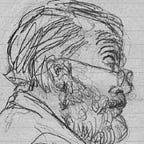Hooking together our digitisation
Contribution to discussion at a miniconference at the Weston Library Oxford on DIY digitisation, 9 January 2016: https://blogs.bodleian.ox.ac.uk/digital/tag/diy-digitization
I’m fascinated by the early history of manuscript photography. The studio used by the photographer Roger Fenton, famed for his pictures of the Crimean War, to photograph objects in the British Museum, can still be seen on the museum roof. While he worked at the Museum, Fenton made photographs of folios from the early biblical manuscript, the Codex Alexandrinus. In 1872, at the height of a liturgical controversy in the Church of England about the Athanasian Creed, the British Foreign Office commissioned photographs of the Utrecht Psalter to try and get evidence for the date of the psalter. The silver nitrate photographs were only obtained with very great difficulty, and their poor quality caused Thomas Duffus Hardy to catastrophically misdate the manuscript. The Keeper of the Manuscripts, Edward Bond, arranged for the Utrecht Psalter to be deposited in the British Museum to try and resolve the controversy. While the psalter was at the Museum, Bond arranged for superior autotype images of the manuscript to be made, and produced the first photographic facsimile of a complete medieval manuscript.
What was striking about Bond’s initiative was the pragmatic and imaginative way in which he seized the opportunity to exploit the new technology of photography. Moreover, Bond enthusiastically built on the success of the Utrecht Psalter facsimile to launch the New Palaeographical Society, which used the autotype method to produce a systematic selection of photographs of key manuscripts from a number of national collections. Bond also experimented with the use of photographs in the Museum’s exhibitions.
I worry that, in our approaches to digital imaging, concerned with question of cost, quality and preservation, we have lost something of that liberal spirit of Victorian curators like Bond, who were quick to seize opportunities as they present themselves. But one of the most exciting developments of recent years has been the growth of do-it-yourself photography in archives and libraries. The trail was blazed by the National Archives, which didn’t have the same copyright concerns as other libraries, and I have been happily been taking digital images at the National Archives for ten years now. Over that period, hundreds of images have been taken every day by readers at Kew, and there must now been hundreds of thousands of images from the National Archives in existence. And now recently it is enormously exciting that other institutions like the Bodleian Library and the British Library have been able to follow the example of the National Archives.
In a corner of the Manuscripts Reading Room at the British Library, you will find a large number of volumes in which prints of photographic negatives of BL manuscripts have been pasted. These negatives were also carefully recorded in card indexes. This meant that the photography undertaken by the Library could be reused, keeping down costs for readers and reducing wear and tear on the manuscripts. It has always seemed to me strange that there is not a similar system for archiving digital images, which can be more readily reproduced than photographic negatives. If the Library had been doing this for the past twenty years, it would now amount to a huge resource.
What the Libraries haven’t done, we now have the opportunity to do. While the ability to take our own images of manuscripts is incredibly convenient and reduces costs and time for scholars who have to travel to archives, it is worth stressing that there are other strategic advantages to sharing and archiving the images we take. The kind of formal digitisation that libraries have so far undertaken is of a high quality but expensive and demanding in terms of resources. Libraries see digitisation as an additional cost, and the need to justify that cost frequently means that they focus on canonical items, which will be of public interest. This misses one of the key advantages of digitisation, namely its ability to open up new and neglected primary materials. Above all, the pressure on libraries to undertake digitisation without extra money means that they are forced to make commercial partnerships for digitisation, in the way that the British Library has done for its historic newspapers, so that access to the full collection of the BL’s newspapers away freom St Pancras is more expensive than a television licence.
So, by sharing the images that we take and using them to open up neglected classes of material, we can head off the threat that large classes of material will become digitally privatised by commercial companies like Findmypast. However, in achieving that we should try and keep it simple — no elaborate infrastructure or complex metadata requirements. Ideally, in my view, just callmarks and images. A good example for us is the way in which family historians build up large scale resources by very simple means of sharing information and increasingly information. I was very alarmed recently by my visit to the British Library Manuscripts Room to see the way in which the bureaucracy associated with self-photography was no dominating the room, with green stickers for desks where photography is permitted, red stickers for desks with select manuscripts, etc. It seemed to have moved away from the initial simplicity of the arrangements in the National Archives to have created unnecessary complications. There is a risk that the same thing will happen if we try and share in too elaborate a fashion.
The philosophy of open source development is one of building from the ground up by sharing, without designing elaborate infrastructures first. This is the same approach we need to adopt in thinking about using self-service photography to create larger manuscript libraries. If we can do that, it is perhaps the best chance we have of rivalling the larger commercial outfits like Findmypast.
